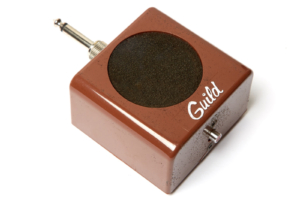 Here’s a fun little bit of Guild history from the 1982 Guild Accessories Catalog: The Guild Tweedy Bird MM500 Micro Mini Amp, and yes, that’s the name, though it depends on where you look as to whether it’s the Tweedy Bird, MM500, or Micro Mini Amp. What are the features? What do all the controls do? How’s it sound? Can you use it as a recording interface? Does it take micro-SD cards? Is it USB-C compatible? Some of these questions might actually be answered in this riveting review, so let’s take a look at this tiny transistor amp from the early 1980s.
Here’s a fun little bit of Guild history from the 1982 Guild Accessories Catalog: The Guild Tweedy Bird MM500 Micro Mini Amp, and yes, that’s the name, though it depends on where you look as to whether it’s the Tweedy Bird, MM500, or Micro Mini Amp. What are the features? What do all the controls do? How’s it sound? Can you use it as a recording interface? Does it take micro-SD cards? Is it USB-C compatible? Some of these questions might actually be answered in this riveting review, so let’s take a look at this tiny transistor amp from the early 1980s.
Intro
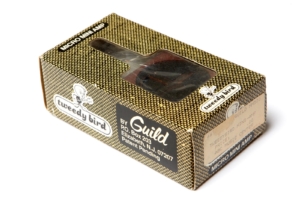 I’ve managed to find one of these basically new-in-box (NIB) which was something I never knew I needed until Kurt (Grot) over at The Guilds of Grot showed me his in a gently mocking tone that insinuated that he had one and I did not. Thankfully I’m not susceptible to such childish antics and did not feel the need to run out and buy one. Well, certainly not the first one I came across. No, I waited six months.
I’ve managed to find one of these basically new-in-box (NIB) which was something I never knew I needed until Kurt (Grot) over at The Guilds of Grot showed me his in a gently mocking tone that insinuated that he had one and I did not. Thankfully I’m not susceptible to such childish antics and did not feel the need to run out and buy one. Well, certainly not the first one I came across. No, I waited six months.
OK, four.
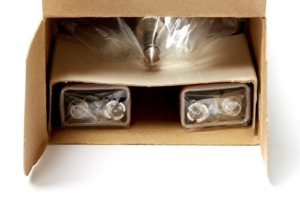 Finding one of these in unmolested condition is a bit of a rarity and people that have them tend to want a lot of money for them. I can’t really blame them for that since anything NIB from 1982 is going to have a premium attached to the price, but are these little amps worth it? This one even has the original batteries still wrapped up and ready to go, though the empty space between them in the box makes me wonder if I’m missing something. All I know is that if there some missing piece that Grot better not have one. Not that I care…
Finding one of these in unmolested condition is a bit of a rarity and people that have them tend to want a lot of money for them. I can’t really blame them for that since anything NIB from 1982 is going to have a premium attached to the price, but are these little amps worth it? This one even has the original batteries still wrapped up and ready to go, though the empty space between them in the box makes me wonder if I’m missing something. All I know is that if there some missing piece that Grot better not have one. Not that I care…
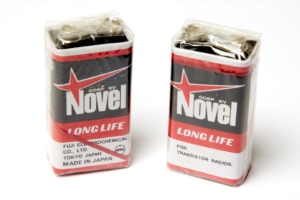
Those 9V batteries are of the sexy import “Long Life” variety which as a kid always cracked me up because “long life” on a battery was pretty much code for “barely useful”. At least they were designed for transistor radios, which, if you haven’t guessed by now, is exactly what this little amp sounds like, but with an extra bit of surprise thrown in that I was completely unprepared for. What is that surprise? If I told you here then it wouldn’t be a surprise, now would it?
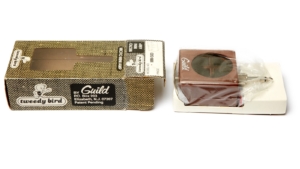 The packaging is simple and covered in a tweed pattern along with the Tweedy Bird logo and a very obvious ripoff of the Warner Brothers Tweety Bird character. I don’t know how Guild got away with that or if they even did, but can you imagine the fallout if a company tried that today? I must also admit that I didn’t realize until I had the box in my hands that the little amp is a TweeDy Bird and the joke only clicked in my feeble brain because of the tweed pattern on the box. I are smart.
The packaging is simple and covered in a tweed pattern along with the Tweedy Bird logo and a very obvious ripoff of the Warner Brothers Tweety Bird character. I don’t know how Guild got away with that or if they even did, but can you imagine the fallout if a company tried that today? I must also admit that I didn’t realize until I had the box in my hands that the little amp is a TweeDy Bird and the joke only clicked in my feeble brain because of the tweed pattern on the box. I are smart.
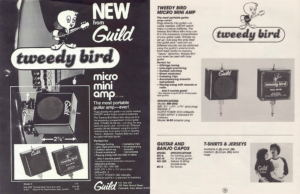 The Tweedy Bird Micro Mini Amp (model MM500) is shown on page 10 of the 1982 Guild Axcessories catalog, though if you look at the picture on that page you may notice that the toggle switch is different and more closely resembles the mini-toggles used on Guild electrics of the same era. The logo is also upside down compared to the one I have, so there are definitely some variations of this amp out there.
The Tweedy Bird Micro Mini Amp (model MM500) is shown on page 10 of the 1982 Guild Axcessories catalog, though if you look at the picture on that page you may notice that the toggle switch is different and more closely resembles the mini-toggles used on Guild electrics of the same era. The logo is also upside down compared to the one I have, so there are definitely some variations of this amp out there.
I love the marketing copy for this little amp claiming that it’s perfect for outdoor jamming, street musicians, accompanying acoustic instruments, and a host of other bulleted items with the final addition of, … and it sounds good! I’ll let you be the judge of how good a transistor radio-esq amp with a 2″ speaker sounds when you listen to the sound clips below, and I’m not sure how far the sound would actually carry while busking, but given the competition at the time which was probably limited to the much larger Pignose, it definitely had its place.
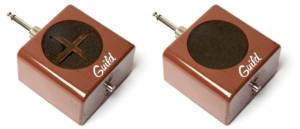 By the way that image on the top of the page is one of the very rare times that I’ve fundamentally altered an image to make it look better for an article. Here you can see the original image which is how the Tweedy Bird came to me, and on the right is my altered version to make it look how it would have appeared in 1978. As you’ll see as this article progresses, the speaker grille is a known problem on these little amps, and that pic on the left is one of the best-looking examples I’ve ever seen for sale. Well, in the past 30 years, anyway.
By the way that image on the top of the page is one of the very rare times that I’ve fundamentally altered an image to make it look better for an article. Here you can see the original image which is how the Tweedy Bird came to me, and on the right is my altered version to make it look how it would have appeared in 1978. As you’ll see as this article progresses, the speaker grille is a known problem on these little amps, and that pic on the left is one of the best-looking examples I’ve ever seen for sale. Well, in the past 30 years, anyway.
Actual Source
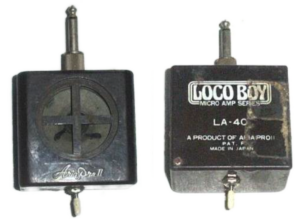 Guild is pretty famous for licensing other companies electronics and printing their own name on it, and that’s exactly what they’ve done with the Tweedy Bird. The Guild Tweedy bird is the same as the Aria Pro II LA40 Loco Boy manufactured by Tiger Electronics Mfg. in Japan and kudos to Effects Database for linking them together. Surprisingly I was unable to find any of these Loco Boys having been bought or sold or any reference to them whatsoever save for this single article in Electronic Music Maker magazine from 1981. If you’ve got one let me know in the comments.
Guild is pretty famous for licensing other companies electronics and printing their own name on it, and that’s exactly what they’ve done with the Tweedy Bird. The Guild Tweedy bird is the same as the Aria Pro II LA40 Loco Boy manufactured by Tiger Electronics Mfg. in Japan and kudos to Effects Database for linking them together. Surprisingly I was unable to find any of these Loco Boys having been bought or sold or any reference to them whatsoever save for this single article in Electronic Music Maker magazine from 1981. If you’ve got one let me know in the comments.
In researching this amp I also discovered that the Guild model 4 that I reviewed is an Aria MX60 Loco Tiger and that the entire line of similar small amps from that time were all made by Aria, so I updated that article as well.
Features
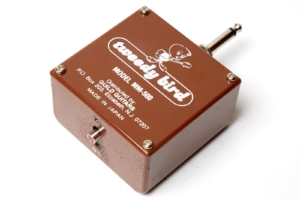 Usually in this section of my amp reviews I list all the features and describe how they work along with a copy of the instruction manual. Here’s a list of the features found on MM500 Tweedy Bird Micro Mini Amp:
Usually in this section of my amp reviews I list all the features and describe how they work along with a copy of the instruction manual. Here’s a list of the features found on MM500 Tweedy Bird Micro Mini Amp:
- On/Off switch
Yup — that’s it. Hell, the screws that hold on the back plate aren’t even recessed.
This little amp is obviously designed to just cram into the output jack on your guitar, but if you have a Strat or any guitar with a similar flat-mount recesses output jack, it won’t fit. According to the catalog, to make that work you’d need the M-55 adaptor plug of which there is no picture so I have no idea what it looks like or if it fits in that void between the two batteries in the original box.
I bet Grot’s got one. Grumble…
Cabinet and Grille
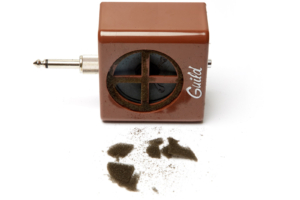 The cabinet for this little Tweedy Bird is not tweed. Nor is it wood or metal. It’s plastic, and not terribly robust plastic at that. The back is held on with four screws that, if over-torqued, will absolutely crack the case.
The cabinet for this little Tweedy Bird is not tweed. Nor is it wood or metal. It’s plastic, and not terribly robust plastic at that. The back is held on with four screws that, if over-torqued, will absolutely crack the case.
The grille on the Tweedy Bird is pretty famously made out of that terrible foam widely used in the ’70s and ’80s that simply disintegrates over time. Finding one of these amps in NIB condition was exciting because it had the original foam as previously discussed, but as you can see in the picture in this section, after carefully photographing the amp while unpacking it the speaker foam just fell away. I’m honestly amazed that it survived shipping intact, a fact that I attribute to the amp having never been unpacked from the plastic in the box.
Designing A New Grille
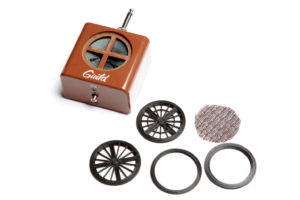 One of my many hobbies is 3D printing, and in an effort to try and make the Guild Tweedy Bird amp more visually appealing, I set out to try and make a new grille using the 3D printer as a rapid prototyping tool. My first few attempts are shown here.
One of my many hobbies is 3D printing, and in an effort to try and make the Guild Tweedy Bird amp more visually appealing, I set out to try and make a new grille using the 3D printer as a rapid prototyping tool. My first few attempts are shown here.
Since the original design did not have a ring and instead had glued-in foam, the first thing I had to so was remove all the residual glue and grille dust, which I did with a flat head screwdriver.
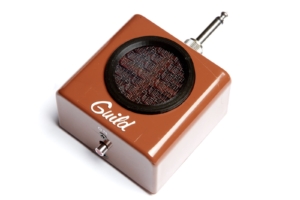 I then set out to make my first design which was a simple ring, the idea being that I could just glue some cloth behind it. I then decided that the ring should have a small lip around it so that the grille cloth could sit within that ring which turned out to be more complicated that I originally thought due to needing something called support in the 3D printing world. Thankfully my printer (then a BCN3D SigMax and now an Ultimaker S5) has dual extruders so I ordered some PVA support material and went to town. I used some oxblood fabric left over from my ’63 Bassman facelift which I thought looked pretty great. Honestly, of all the first batch of solutions, I liked this one the best because it most closely resembled the original design of the Tweedy Bird.
I then set out to make my first design which was a simple ring, the idea being that I could just glue some cloth behind it. I then decided that the ring should have a small lip around it so that the grille cloth could sit within that ring which turned out to be more complicated that I originally thought due to needing something called support in the 3D printing world. Thankfully my printer (then a BCN3D SigMax and now an Ultimaker S5) has dual extruders so I ordered some PVA support material and went to town. I used some oxblood fabric left over from my ’63 Bassman facelift which I thought looked pretty great. Honestly, of all the first batch of solutions, I liked this one the best because it most closely resembled the original design of the Tweedy Bird.
 Although I liked the ring and fabric, I wanted to try some rings that would work as standalone grilles, the first of which being this one. I think it works reasonably well and like the previous example, is held in place with a couple of drops from a hot glue gun. The biggest issue with these non-fabric designs is trying to hide the ugly speaker crossbars which is why these solutions have the large X-shaped supports on them. After multiple attempts to minimize the impact of those large crossbars I decided to just embrace them and make all the radial pieces roughly the same.
Although I liked the ring and fabric, I wanted to try some rings that would work as standalone grilles, the first of which being this one. I think it works reasonably well and like the previous example, is held in place with a couple of drops from a hot glue gun. The biggest issue with these non-fabric designs is trying to hide the ugly speaker crossbars which is why these solutions have the large X-shaped supports on them. After multiple attempts to minimize the impact of those large crossbars I decided to just embrace them and make all the radial pieces roughly the same.
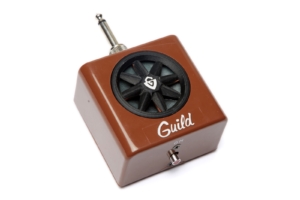 In order to try and further hide the speaker I added some various rings and patterns, some of which I liked, and some of which I didn’t. After having some 3D printer issues which resulted in me returning not one, but two expensive machines (the aforementioned BCN3D Sigma and SigMax), I finally got one that I liked (an Ultimaker S5) and with that machine I was able to kick the designs up a notch thanks to the improved reliability and working dual extrusion capabilities. This last design is the one that sits on the amp today because I think the little G-shield logo is cool and adds a bit of contrast.
In order to try and further hide the speaker I added some various rings and patterns, some of which I liked, and some of which I didn’t. After having some 3D printer issues which resulted in me returning not one, but two expensive machines (the aforementioned BCN3D Sigma and SigMax), I finally got one that I liked (an Ultimaker S5) and with that machine I was able to kick the designs up a notch thanks to the improved reliability and working dual extrusion capabilities. This last design is the one that sits on the amp today because I think the little G-shield logo is cool and adds a bit of contrast.
Controls
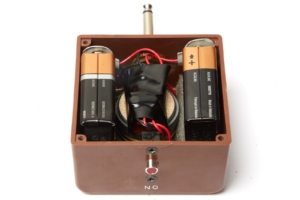 The controls are as nonexistent as the features. This little amp has an on/off switch and that’s it. No tone, and more to the point, no volume. Luckily every electric guitar I’ve ever played has a volume knob on it, so that’s not really the end of the world. As noted elsewhere some examples of this amp may have a mini-toggle instead of the slider switch seen on mine.
The controls are as nonexistent as the features. This little amp has an on/off switch and that’s it. No tone, and more to the point, no volume. Luckily every electric guitar I’ve ever played has a volume knob on it, so that’s not really the end of the world. As noted elsewhere some examples of this amp may have a mini-toggle instead of the slider switch seen on mine.
Electronics
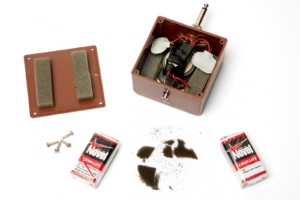 If you’re wondering, this is not a tube amp, and if you’re wondering that you might want to remember or read up on what 1982 was like because solid state was the solution to all of our problems, though admittedly I don’t know that we had accepted “solid state tone” as a problem quite yet. Also making a tube amp this size that runs on 9V batteries was a hurdle not yet cleared that I’m aware of. Even today the only battery operated tube amps I’m familiar with are for headphone amps running with tiny Russian tubes and using Russian tubes in the ’80s would have been downright treasonous.
If you’re wondering, this is not a tube amp, and if you’re wondering that you might want to remember or read up on what 1982 was like because solid state was the solution to all of our problems, though admittedly I don’t know that we had accepted “solid state tone” as a problem quite yet. Also making a tube amp this size that runs on 9V batteries was a hurdle not yet cleared that I’m aware of. Even today the only battery operated tube amps I’m familiar with are for headphone amps running with tiny Russian tubes and using Russian tubes in the ’80s would have been downright treasonous.
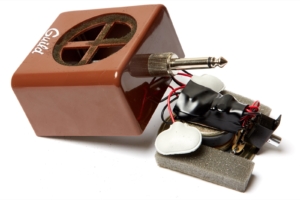 The design of this amp is kind of interesting in that the guts of the thing are just sort of held in place by the pressure exerted by the batteries sitting between pieces of foam attached to both the speaker and the back plate. Aside from two screws holding the on/off switch to the side of the case, the electronics are just glued to the speaker. The speaker is not held into place by anything other than the compression of that foam.
The design of this amp is kind of interesting in that the guts of the thing are just sort of held in place by the pressure exerted by the batteries sitting between pieces of foam attached to both the speaker and the back plate. Aside from two screws holding the on/off switch to the side of the case, the electronics are just glued to the speaker. The speaker is not held into place by anything other than the compression of that foam.
The amp guts are basically comprised of an LM-386N-1 amplifier chip with some coupling caps. There’s really not a lot going on in there aside from the existence of that chip. So what’s the deal with the LM-386N-1?
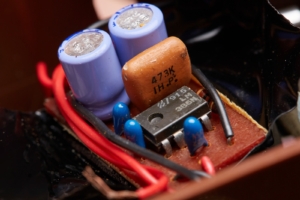 The spec sheet for the LM386N lists the following common uses:
The spec sheet for the LM386N lists the following common uses:
• AM-FM radio amplifiers
• Portable tape player amplifiers
• Intercoms
• TV sound systems
• Line drivers
• Ultrasonic drivers
• Small servo drivers
• Power converters
The LM386N is a general purpose amplifier capable of driving a speaker even when starting from a weak source signal. If you’d like to learn more about the LM386N chip, check out this Hackaday article, and this modern DIY Ruby guitar amplifier based on the chip. Also in case you’re worried, I did not cut open my NIB Tweedy Bird for the picture of the guts. I have two of them, one I bought for cheap because it didn’t work.
Speaker
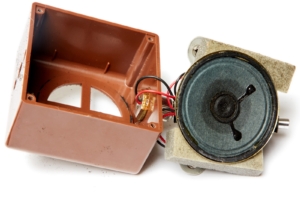 The speaker in the Guild Tweedy Bird is a generic two inch paper cone speaker of the type found in every transistor radio and cheap electronic doo-dad from the era, though it does have a relatively beefy magnet compared with some of the similar speakers I’ve seen. The paper cone is plainly evident in most of the Tweedy Birds for sale since the speaker foam has completely disintegrated in most of them.
The speaker in the Guild Tweedy Bird is a generic two inch paper cone speaker of the type found in every transistor radio and cheap electronic doo-dad from the era, though it does have a relatively beefy magnet compared with some of the similar speakers I’ve seen. The paper cone is plainly evident in most of the Tweedy Birds for sale since the speaker foam has completely disintegrated in most of them.
I could argue that the sound of this tiny amp is most limited by the small inexpensive speaker, though I don’t think the amp itself has what it takes to drive a 4×12 cabinet, either.
Sound
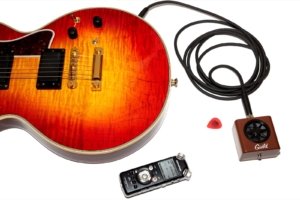 When I first tested the Tweedy Bird, the best way I could describe the sound from this little amp would probably be uninspiring. Remember, this amp wasn’t designed to rock the house. It was designed and built before the magic of surface mount technology, so the attraction was the fact that it could amplify at all given its size which is what it does, and it does it reasonably well given that limitation. The problem is that without any any ability alter the tone, overdrive the signal, or to employ effects, the sound of an electric guitar is rather boring, especially without the character that you would get from a good clean tube amp.
When I first tested the Tweedy Bird, the best way I could describe the sound from this little amp would probably be uninspiring. Remember, this amp wasn’t designed to rock the house. It was designed and built before the magic of surface mount technology, so the attraction was the fact that it could amplify at all given its size which is what it does, and it does it reasonably well given that limitation. The problem is that without any any ability alter the tone, overdrive the signal, or to employ effects, the sound of an electric guitar is rather boring, especially without the character that you would get from a good clean tube amp.
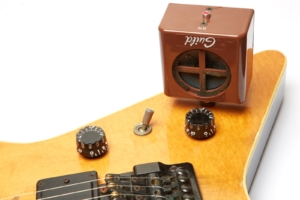 Before we get started, let me say that yes, the amp was recorded using an extension cable. This was done in order to ease the recording process by being able to place the little amp a defined distance from the recorder while being able to play and change guitars. While the extension cable certainly has changed the impedance of the entire affair while also introducing additional capacitance, if you’re cork-sniffing this setup then there’s a good chance you’ve got reading comprehension issues because this solid state amp from the early ’80s has a two inch speaker and a plastic case.
Before we get started, let me say that yes, the amp was recorded using an extension cable. This was done in order to ease the recording process by being able to place the little amp a defined distance from the recorder while being able to play and change guitars. While the extension cable certainly has changed the impedance of the entire affair while also introducing additional capacitance, if you’re cork-sniffing this setup then there’s a good chance you’ve got reading comprehension issues because this solid state amp from the early ’80s has a two inch speaker and a plastic case.
1983 Guild X175
Neck Cleanish
Neck 7th
Bridge Rockin’
Guild Nightbird
Rocky Horror
[/dropshadowbox]With the Tweedy Bird in my X82, I got a thin tinny clean sound, but when I plugged it into my Nightbird II with EMGs, my jaw hit the floor. With some higher output pickups I was able to completely overdrive the little amp and it growled like crazy! To be fair it growled like a baby lion because the speaker is so small, but it growled nonetheless. With the Nightbird’s many tonal options including coil split and phase inversion, I could pull a fair number of interesting tones out of the tiny Tweedy Bird. Color me shocked! So shocked, in fact, that I only recorded one of those tones. In addition to the Nightbird, I recorded my 1983 Guild X175 in a couple of ways that I thought were interesting.
The main thing I took away from this recording session is that it’s very difficult to get a clean sound out of this amp unless you turn the volume down on the guitar, though that was also very guitar-dependent. Low-output pickups on a Strat produce less output than an active EMG, so your mileage may vary.
Remember that the speaker is very small and there’s only so much bass that a roughly two inch plastic enclosure can deliver, so you’re basically limited by physics. In an era where you can use your mobile phone as a super-computer amp modeler, I think the average user of today would quickly grow bored by the Guild Tweedy Bird, but it’s more fun than I thought it would be. I also found it to be an oddly useful tool as I’ll cover in the Conclusion.
Conclusion
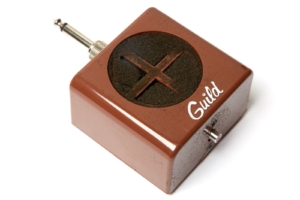 This little amp shows its age in a couple of ways, the first being that it needs two 9V batteries to run, the second being that it has no tone controls and no ability to sound like anything but the pure amplified signals coming from the guitar. As a result it pales in comparison to modern micro amps like the Marshal MS2, the Fender Mini Deluxe, or even the super-cool micro EVH 5150III Micro-stack. Those all require a cable, though, so they’re not really in the same category as the Tweedy Bird. If you want to plug in sans cable, then you’re looking at something like the Vox amPlug2, though those require headphones, and when you get into headphone guitar amps there are countless high quality options out there. Of course today there are plenty of options using your mobile phone as a headphone amp as well.
This little amp shows its age in a couple of ways, the first being that it needs two 9V batteries to run, the second being that it has no tone controls and no ability to sound like anything but the pure amplified signals coming from the guitar. As a result it pales in comparison to modern micro amps like the Marshal MS2, the Fender Mini Deluxe, or even the super-cool micro EVH 5150III Micro-stack. Those all require a cable, though, so they’re not really in the same category as the Tweedy Bird. If you want to plug in sans cable, then you’re looking at something like the Vox amPlug2, though those require headphones, and when you get into headphone guitar amps there are countless high quality options out there. Of course today there are plenty of options using your mobile phone as a headphone amp as well.
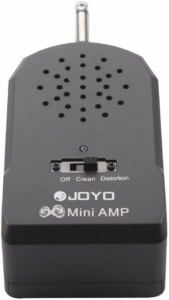 The Guild Micro Mini MM500 Tweedy Bird is relatively unique in that it has a speaker and is designed to be connected to a guitar directly. I didn’t find many current offerings that offered the same thing, although I did find the Joyo JA-01 For under $20 that offers distortion, an mp3-in jack, and the ability to run with external power. It doesn’t say Guild on it and it doesn’t have the cool ’80s retro vibe of the Tweedy bird, so bear that in mind when considering a purchase. I can tell you that the Joyo is the exact kind of item that Guild would have licensed their name to if they were around today. The Guild of today is not the same company, if you weren’t already aware of that fact, but if the current Guild clip-on tuner is any indication, they’re not afraid to put their name on crappy electronic gizmos (I have one and was going to review it but the level of negativity in even my initial thoughts about the tuner were too much for print).
The Guild Micro Mini MM500 Tweedy Bird is relatively unique in that it has a speaker and is designed to be connected to a guitar directly. I didn’t find many current offerings that offered the same thing, although I did find the Joyo JA-01 For under $20 that offers distortion, an mp3-in jack, and the ability to run with external power. It doesn’t say Guild on it and it doesn’t have the cool ’80s retro vibe of the Tweedy bird, so bear that in mind when considering a purchase. I can tell you that the Joyo is the exact kind of item that Guild would have licensed their name to if they were around today. The Guild of today is not the same company, if you weren’t already aware of that fact, but if the current Guild clip-on tuner is any indication, they’re not afraid to put their name on crappy electronic gizmos (I have one and was going to review it but the level of negativity in even my initial thoughts about the tuner were too much for print).
When I use the Tweedy Bird amp, I am not necessarily impressed by its build quality or sound, though I will say I had some fun pushing it far past its likely intended design limits, but everyone I’ve shown it to (including my wife who usually is unimpressed by my many gadgets) has universally responded with, “That’s cool!” Especially with the new grille on it to cover up the speaker.
 Should you rush out and pay the ridiculous prices people seem to be asking for them on Ebay? No, probably not. Should you grab one if you see one for a reasonable price? Sure, so long as you know that the grille will be toast, the case is plastic, and it will sound like you’d expect after hearing my recordings. As a cool little piece of Guild history it’s a fun addition to my collection but I didn’t think that it would get much use. I was wrong, though.
Should you rush out and pay the ridiculous prices people seem to be asking for them on Ebay? No, probably not. Should you grab one if you see one for a reasonable price? Sure, so long as you know that the grille will be toast, the case is plastic, and it will sound like you’d expect after hearing my recordings. As a cool little piece of Guild history it’s a fun addition to my collection but I didn’t think that it would get much use. I was wrong, though.
I’ve discovered that it’s a fantastic little tool to test guitar wiring without having to cable up to a full-sized amp! That convenience is still not worth the price I paid, but I have to admit that I use it all the time now. Well, I use the one I fixed. The NIB one photographed here sits nestled in its box.
Donate: PayPal Crypto:
ETH: 0x0AC57f8e0A49dc06Ed4f7926d169342ec4FCd461
Doge: DFWpLqMr6QF67t4wRzvTtNd8UDwjGTQBGs
Thank you for the article it was very informational, I was just given one by my wife who had found it at a secondhand store for a quarter. Yes that’s 25 cents and in awesome condition – in the box. Well minus the phone cover that had disintegrated of course. I would be willing to bet that the original two nine volts are still in there. Anyway I just wanted to point out that you’d mentioned that there are some variances in the cover of the Tweety Bird logo on the app whether yours was upside down or sideways , left to right the right to left. I guess that would depend on how it was put back on after removing the four screws. Hahaha. There’s your variance. Just saying thanks for the laugh thanks for the article